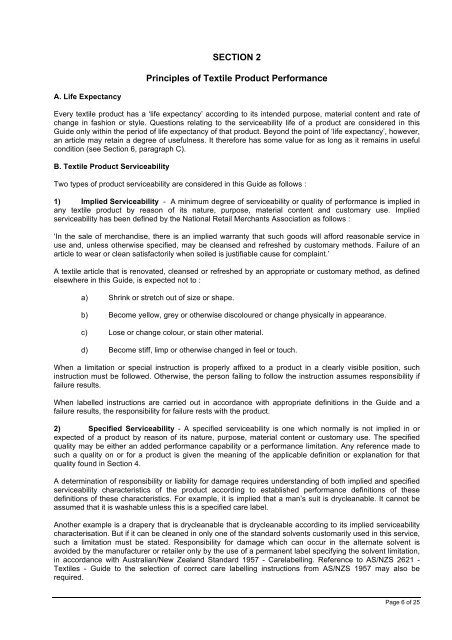international fair claims guide for consumer textiles products
international fair claims guide for consumer textiles products
international fair claims guide for consumer textiles products
You also want an ePaper? Increase the reach of your titles
YUMPU automatically turns print PDFs into web optimized ePapers that Google loves.
A. Life Expectancy<br />
SECTION 2<br />
Principles of Textile Product Per<strong>for</strong>mance<br />
Every textile product has a ‘life expectancy’ according to its intended purpose, material content and rate of<br />
change in fashion or style. Questions relating to the serviceability life of a product are considered in this<br />
Guide only within the period of life expectancy of that product. Beyond the point of ‘life expectancy’, however,<br />
an article may retain a degree of usefulness. It there<strong>for</strong>e has some value <strong>for</strong> as long as it remains in useful<br />
condition (see Section 6, paragraph C).<br />
B. Textile Product Serviceability<br />
Two types of product serviceability are considered in this Guide as follows :<br />
1) Implied Serviceability - A minimum degree of serviceability or quality of per<strong>for</strong>mance is implied in<br />
any textile product by reason of its nature, purpose, material content and customary use. Implied<br />
serviceability has been defined by the National Retail Merchants Association as follows :<br />
‘In the sale of merchandise, there is an implied warranty that such goods will af<strong>for</strong>d reasonable service in<br />
use and, unless otherwise specified, may be cleansed and refreshed by customary methods. Failure of an<br />
article to wear or clean satisfactorily when soiled is justifiable cause <strong>for</strong> complaint.’<br />
A textile article that is renovated, cleansed or refreshed by an appropriate or customary method, as defined<br />
elsewhere in this Guide, is expected not to :<br />
a) Shrink or stretch out of size or shape.<br />
b) Become yellow, grey or otherwise discoloured or change physically in appearance.<br />
c) Lose or change colour, or stain other material.<br />
d) Become stiff, limp or otherwise changed in feel or touch.<br />
When a limitation or special instruction is properly affixed to a product in a clearly visible position, such<br />
instruction must be followed. Otherwise, the person failing to follow the instruction assumes responsibility if<br />
failure results.<br />
When labelled instructions are carried out in accordance with appropriate definitions in the Guide and a<br />
failure results, the responsibility <strong>for</strong> failure rests with the product.<br />
2) Specified Serviceability - A specified serviceability is one which normally is not implied in or<br />
expected of a product by reason of its nature, purpose, material content or customary use. The specified<br />
quality may be either an added per<strong>for</strong>mance capability or a per<strong>for</strong>mance limitation. Any reference made to<br />
such a quality on or <strong>for</strong> a product is given the meaning of the applicable definition or explanation <strong>for</strong> that<br />
quality found in Section 4.<br />
A determination of responsibility or liability <strong>for</strong> damage requires understanding of both implied and specified<br />
serviceability characteristics of the product according to established per<strong>for</strong>mance definitions of these<br />
definitions of these characteristics. For example, it is implied that a man’s suit is drycleanable. It cannot be<br />
assumed that it is washable unless this is a specified care label.<br />
Another example is a drapery that is drycleanable that is drycleanable according to its implied serviceability<br />
characterisation. But if it can be cleaned in only one of the standard solvents customarily used in this service,<br />
such a limitation must be stated. Responsibility <strong>for</strong> damage which can occur in the alternate solvent is<br />
avoided by the manufacturer or retailer only by the use of a permanent label specifying the solvent limitation,<br />
in accordance with Australian/New Zealand Standard 1957 - Carelabelling. Reference to AS/NZS 2621 -<br />
Textiles - Guide to the selection of correct care labelling instructions from AS/NZS 1957 may also be<br />
required.<br />
Page 6 of 25


